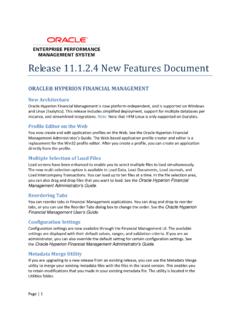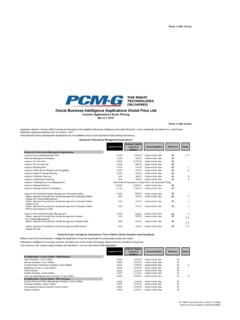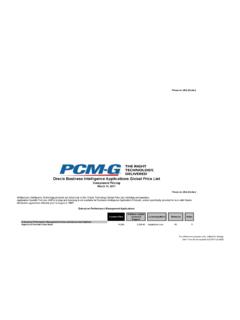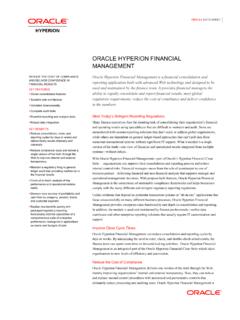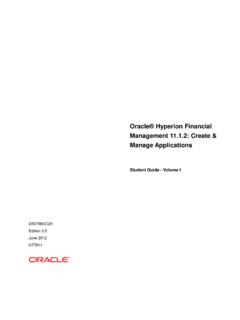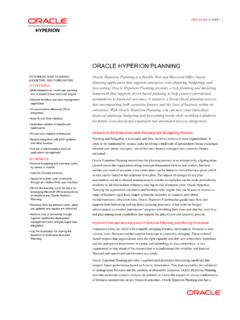Transcription of Oracle Hyperion Financial Management, Fusion Edition ...
1 Oracle s Hyperion Financial management Performance Tuning Guide 1 Oracle Hyperion Financial management , Fusion Edition December 2010 Performance Tuning Guide [Skip Navigation Links] How to Use this Guide .. 3 Introduction .. 3 Performance Overview .. 3 Introduction to Oracle Hyperion EPM System Performance .. 3 Performance Terminology .. 3 Understanding Key Performance Drivers .. 4 Financial management Records and Subcubes .. 4 Tuning Recommendations for Financial management .. 5 Diagnosing Performance 5 Using Monitoring Tools .. 5 Using Remote Diagnostic Agent (RDA) .. 8 Using a Reference Application .. 8 Tune Operating Systems Parameters .. 9 Windows Tuning Parameters .. 9 Tune Windows (32 bit, x86) /3GB switch .. 10 Interaction of the /3GB and /PAE switches .. 11 Side Effects of NOT Tuning when /3GB and /PAE switches are enabled .. 11 Tune the Web Server .. 11 Tune HTTP Server Compression / Caching .. 11 Why use Web Server Compression / Caching for EPM products?
2 11 IIS HTTP Server .. 12 How to Enable Compression .. 12 How to Enable Caching .. 14 Performance Gain 15 Tuning Financial management Applications .. 16 Financial management Application Server Registry Tuning .. 16 Default Memory Settings .. 16 Financial management 32bit Memory Settings for Larger Applications .. 17 Financial management 64bit Memory Settings for Larger Applications .. 18 Registry Settings for Multiple Server Tasks .. 18 Database Tuning .. 20 Oracle s Hyperion Financial management Performance Tuning Guide 2 Basic Design Considerations .. 21 Application-specific Settings .. 22 Application Server Clusters .. 23 Tuning Oracle 11g Databases .. 23 Introduction .. 23 Tuning Guidelines for Oracle 11g Databases .. 23 Oracle Initialization Parameters .. 23 How to Determine Memory Settings for Oracle Database Release 11g .. 27 Total Memory Sizing (MEMORY_TARGET) .. 27 SGA Sizing (SGA_TARGET) .. 28 PGA Sizing (PGA_AGGREGATE_TARGET) .. 28 LOG_BUFFER Sizing.
3 28 How to Calculate the Number of Processes for Oracle Database Release 11g .. 29 Other Considerations .. 29 Shared Server vs. Dedicated Server .. 29 Online Redo Log Files Size .. 30 Tablespaces and Segments Fragmentations .. 30 Index Fragmentations .. 30 Regular Maintenance and Tuning Plans .. 30 64-Bit Environments .. 31 What is 64-bit Financial management ? .. 31 32-bit vs. 64-bit Environments .. 31 Financial management s Memory Requirements .. 31 Who Benefits? .. 32 What Aspects of Performance Are not Affected? .. 32 Case Studies .. 33 Summary .. 37 Frequently Asked Questions .. 37 Which Operating Systems are supported? .. 37 Which CPUs are supported? .. 38 How does one migrate from 32-bit to 64-bit Financial management ? Will 64-bit Financial management work with an application created under 32-bit Financial management ? .. 38 Which components of the system need to be 64-bit? In particular, does the relational database need to be 64-bit? .. 38 What are the benefits of 64-bit Financial management ?
4 38 What are the memory limitations of 64-bit Financial management ? .. 38 Are there any memory settings that need to be tuned for 64-bit Financial management ? .. 38 What kind of applications will see the most benefit? .. 39 What kind of applications will see the least benefit? .. 39 Oracle s Hyperion Financial management Performance Tuning Guide 3 How to Use this Guide This document contains information intended to assist with performance tuning of Financial management . This tuning guide is intended as an aid for people responsible for the operation and maintenance of Financial management . Readers should be very familiar with the Financial management application, database administration, and general operating system concepts to fully leverage the guidelines in this guide. Caution: Improper settings and configurations may prevent Financial management from working. This document presents general guidelines for users. Specific users actual implementations and environments will vary widely based on business requirements, the user s Financial management data set, network topology, and hardware usage.
5 Therefore, users must consider how to adapt these guidelines to their own implementations. All tuning information stated in this guide is only for orientation, every modification has to be tested and its impact should be monitored and analyzed. All test results and performance numbers are only intended as examples to illustrate tuning concepts. Before implementing any of the tuning settings, it is recommended to carry out end to end performance testing to obtain baseline performance data for the default configurations, make incremental changes to the tuning settings and then collect performance data. Otherwise it may impair system performance. Note: This guide is specific to Financial management . It is not release-specific, but generally applies to the releases. Release-specific notes are indicated as appropriate throughout the document. For the Oracle Enterprise Performance management System Supported Platform Matrix for each release, click here: Top of Document Introduction This document is written for people who monitor performance and tune the components in an EPM/BI environment.
6 It is assumed that readers know server administration and hardware performance tuning fundamentals, web servers, java application servers and database. Performance Overview Introduction to Oracle Hyperion EPM System Performance To maximize Oracle Hyperion EPM System performance, you need to monitor, analyze, and tune all the components. This guide describes the tools that you can use to monitor performance and the techniques for optimizing the performance of Oracle Hyperion EPM System components, for example Financial management , Essbase, Reporting and Analysis and Planning. Performance Terminology This guide uses the following performance terms: Oracle s Hyperion Financial management Performance Tuning Guide 4 Scalability The system's ability to perform within specification under increasing user load, data load and hardware expansion. Latency The time between the issuing of a request and the time when the work actually begins on the request. Think time The time a real user pauses to think between actions.
7 Resource utilization A consumption metric, for example, the percent of CPU usage. Response time A time metric, for example round-trip time it takes the server to deliver a Web page. Throughput A rate metric (requests per unit of time), for example, requests per second, bits per second. For example, if an application can handle 20 customer requests simultaneously and each request takes one second to process, this site has a potential throughput of 20 requests per second. Understanding Key Performance Drivers To optimize your deployment, you must understand the elements that influence performance and scalability. A factor that dictates performance is called a key performance driver. Knowing how the drivers behave in combination further enhances your ability to deploy Oracle Hyperion EPM system optimally, based on the unique requirements of each deployment. Hardware Capacity - Factors such as number of servers, quantity and speed of processors, available RAM, network speed etc.
8 Technical Platforms Tuning Fine tuning other third party software required for installing and running Oracle Hyperion EPM products; for example: relational databases, Java application servers, Web servers, Server / Client Operating System and browsers. Business Application Design - Application design is an important factor in system performance structure, size, and use of product features in designing applications databases, reports, Web data entry forms, calculations and consolidations. Business Process Usage - Activities carried out by users in the normal flow of your business cycle. Business process usage has three components: User activity Activities available to users for data load or data entry, database processing (consolidations, copy, clear, and so on), and reporting and analysis. Rate of user activity A number of transactions executed by one user per one hour. User concurrency Number of users for each activity being carried out simultaneously.
9 Financial management Records and Subcubes A record in Financial management holds the data for all base periods for a given intersection of dimension members, and a subcube is a collection of records that all belong to the same Entity, Scenario, Year, and Value (currency). Within a subcube there are six dimensions: Account, ICP and Custom 4. Because the subcube is a natural unit of data for the purposes of consolidation, Oracle s Hyperion Financial management Performance Tuning Guide 5 data movement and processing are carried out on a subcube basis in many places in Financial management . Tuning Recommendations for Financial management Performance tuning Financial management is a complex and iterative process. To get you started, this document includes recommendations to help you optimize your Financial management system performance. Note: tuning has to be done for a particular production workload. Tuning can be conducted when workload is generated by load generation tools like Oracle Application Testing Suite (ATS) or LoadRunner by HP.
10 This document touches on several areas that provide a quick start for performance tuning Financial management , including: Tune Operating Systems parameters Tune HTTP Server parameters Tune HTTP Server Compression / Caching Tune Oracle Database Parameters Hyper-Threading / SMT Considerations Note: while the list in each of the above stated section is a useful tool in starting your performance tuning, it is not meant to be comprehensive list of areas to tune. You must monitor and track specific performance issues within your implementation to understand where tuning can improve performance. Top of Document Diagnosing Performance Problems When a performance issue arises, it is critical to first determine the cause prior to taking any corrective action. Oracle does not recommend changing performance-related parameter settings or taking other actions until an extensive analysis of the problem has been performed. Using Monitoring Tools Oracle strongly recommends using monitoring tools to collect performance data as part of the diagnostic process.

